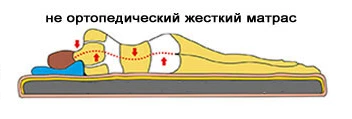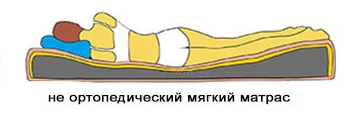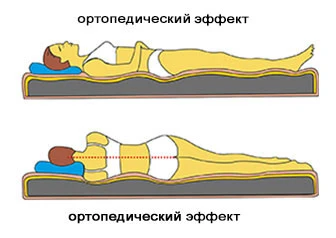Which better to choose a mattress for hardness?
Which better to choose a mattress for hardness?
Mollyflex® does not divide mattresses into hard and soft mattresses. And why?
Hard mattress
We choose the lesser of two evils. Previously, when there was no alternative, people were faced with what was recommended to them, including orthopedics, to sleep on a rigid mattress, as the situation on a soft mattress is even worse (about this below).
The main disadvantage of hard mattresses is that you have to adjust under the mattress. Do you know a situation where you toss and turn to find a comfortable position instead of sleeping? A hard mattress cannot ensure the natural position of the spine during sleep. For example, when you lie on the side, the shoulder, and hip are not «drowned» and the spine has to bend.

No better situation than during sleep on the back. As you know, our spine is not a straight line and has an S-shaped form. Again, the protruding parts of the body do not immerse themselves in the mattress, and the lower back is suspended, energized, and very heavy to test the shoulders and thighs. In this position, there is one way to unload the lower back – bend the legs in the knees, but so, unfortunately, we can not sleep. So the fact that a hard mattress can be orthopedic is a myth.
Another important aspect is the reverse pressure that a rigid mattress exerts on our body. Soft tissues are at risk, and the joints are under increased pressure and the blood circulation is disrupted.
How many times do you roll over in a dream? And that’s just the flips we notice. Every time you toss and turn in your sleep, you go out of the deep phase of sleep and into the phase of micro-shock – in this phase, the brain does not rest, therefore you do not sleep (it is about when you have enough time to sleep).
Everyone is familiar with the situation when the extremities «numb» occurs, again, due to excessive counter pressure.
Elderly people are generally prohibited from sleeping on hard mattresses, as their vessels and tissues are more sensitive and they are prone to numbness of limbs of hands and legs, pain in joints.
Soft mattress
A soft mattress, unlike a hard mattress, does not exert so much undue pressure on the body of a lying person. But it doesn’t provide any spinal support. Since 50% of the body weight falls on the middle third of the body, the spine bends, the so-called «hammock effect» is formed – the lower back goes down, and the head and legs remain above. This situation causes back and neck pain, anxiety, frequent headaches and even spinal cord damage.

Heavier to get up, a correspondingly large load is also on the knee joints.
All Mollyflex® memory mattresses combine the right orthopedic support and relaxation. This is achieved by the properties of the Memory viscoelastic® material, which is heat sensitive and adjusted individually for each person lying on it, and most importantly, does not shrink the lumbar area, under pressure from the hip and shoulder area, the mattress immerses these parts of the body, but does not fade out in the area of the lumbar, i.e. in this case the «hammock effect» is excluded.

With love, the company Mollyflex®
Articles
Mollyflex® does not divide mattresses into hard and soft mattresses. And why?
Hard mattress
We choose the lesser of two evils. Previously, when there was no alternative, people were faced with what was recommended to them, including orthopedics, to sleep on a rigid mattress, as the situation on a soft mattress is even worse (about this below).
The main disadvantage of hard mattresses is that you have to adjust under the mattress. Do you know a situation where you toss and turn to find a comfortable position instead of sleeping? A hard mattress cannot ensure the natural position of the spine during sleep. For example, when you lie on the side, the shoulder, and hip are not «drowned» and the spine has to bend.

No better situation than during sleep on the back. As you know, our spine is not a straight line and has an S-shaped form. Again, the protruding parts of the body do not immerse themselves in the mattress, and the lower back is suspended, energized, and very heavy to test the shoulders and thighs. In this position, there is one way to unload the lower back – bend the legs in the knees, but so, unfortunately, we can not sleep. So the fact that a hard mattress can be orthopedic is a myth.
Another important aspect is the reverse pressure that a rigid mattress exerts on our body. Soft tissues are at risk, and the joints are under increased pressure and the blood circulation is disrupted.
How many times do you roll over in a dream? And that’s just the flips we notice. Every time you toss and turn in your sleep, you go out of the deep phase of sleep and into the phase of micro-shock – in this phase, the brain does not rest, therefore you do not sleep (it is about when you have enough time to sleep).
Everyone is familiar with the situation when the extremities «numb» occurs, again, due to excessive counter pressure.
Elderly people are generally prohibited from sleeping on hard mattresses, as their vessels and tissues are more sensitive and they are prone to numbness of limbs of hands and legs, pain in joints.
Soft mattress
A soft mattress, unlike a hard mattress, does not exert so much undue pressure on the body of a lying person. But it doesn’t provide any spinal support. Since 50% of the body weight falls on the middle third of the body, the spine bends, the so-called «hammock effect» is formed – the lower back goes down, and the head and legs remain above. This situation causes back and neck pain, anxiety, frequent headaches and even spinal cord damage.

Heavier to get up, a correspondingly large load is also on the knee joints.
All Mollyflex® memory mattresses combine the right orthopedic support and relaxation. This is achieved by the properties of the Memory viscoelastic® material, which is heat sensitive and adjusted individually for each person lying on it, and most importantly, does not shrink the lumbar area, under pressure from the hip and shoulder area, the mattress immerses these parts of the body, but does not fade out in the area of the lumbar, i.e. in this case the «hammock effect» is excluded.

With love, the company Mollyflex®
